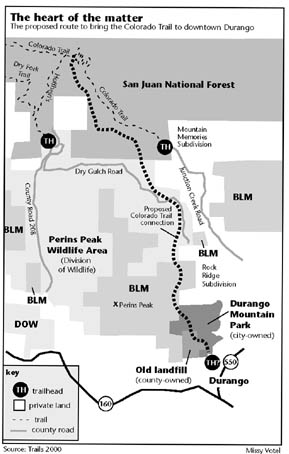|  ‘No
compromise’ ‘No
compromise’
In 1971, the 10,000-acre Perins
Peak State Wildlife Area was bought and set aside for species
including peregrine falcons, deer, elk, bears, bobcats and songbirds.
From November through July, the area is closed to all human travel
to facilitate pristine wintering grounds. Despite its proximity
to Durango, the area is considered prime low-elevation habitat.
The most vocal opponents of extending the Colorado Trail into
Durango maintain that it would fragment this habitat, and they
have forward a stance of “no compromise.” Renee Parsons,
of the Coalition to Save Perins Peak, vigorously opposes the trail
extension for one reason: “wildlife, wildlife, wildlife.”
The coalition contends that
the trail would bring as many as 30,000 people a year through
the area, cut through habitat and displace wildlife, even along
its edge. “The trail looks to be benign,” says Parsons.
“But as any biologist would tell you, this is habitat fragmentation.”
Jan Holt, of the coalition,
concurs. “There can be no compromise,” she said. “If
the land is swapped, it’s a lose/lose for wildlife. You’re
just designating another area that already has wildlife as wildlife
habitat. It’s not a logical excuse.”
Speaking to the pristine nature
of the area, Parsons noted that 136 species of songbirds have
been identified in the wildlife area. “That’s almost
20 percent of the national total,” she says. “That,
to us, is a real metaphor for how pristine Perins is. Songbirds
are taking the biggest hit in the mass-extinction cycle that’s
under way now.”
And while Parsons and Holt acknowledge
that the area is open to hunting, Parsons notes that “the
number of hunters who go in there is miniscule compared to 30,000
hikers and bikers.”
Ulterior motives?
Parsons and Holt argue that
there might be other motives at work on the part specifically
of Trails 2000. “With approximately 600 miles of trails
in La Plata County, the only justification we can see is self
interest, whether it be economic or otherwise,” says Parsons.
Holt adds: “This is such
a no-brainer as far as we’re concerned. There are already
so many trails to hike and bike on.”
Holt goes on to say that she
feels Trails 2000 has had its eye on the wildlife area for years,
not simply for a Colorado Trail extension but as a new area for
a trails network. She concludes by saying: “It’s not
like there’s a trail in the forest that we’re trying
to take away. This should remain a protected area. That’s
why it was purchased.”
Parsons adds that the sanctity
of the Perins Peak State Wildlife Area is particularly important
in light of the degradation of other areas of La Plata County.
“We feel this has really tapped a nerve with the public,
especially those who’ve been here for a long while and seen
us lose herds of elk,” she said. “We’ve all
seen the plight of the bear.
“The immediate gratification
of a few backpackers and bikers can’t be bought at the price
of Perins Peak.”
Trails 2000 reacts to these
concerns with an apparently conciliatory tone. “The reality
is, we understand those concerns,” says Crites. “We’re
trying to skirt (the trail) and have it as close to town and as
far away from the heart of the wildlife area as possible.”
Manning adds that in his opinion,
wildlife and trails are not in opposition.
"Generally, trails and wildlife
seem to coexist pretty well, which of course is something that
we all observe,” he says. “I see wildlife from trails
all the time.”
|

